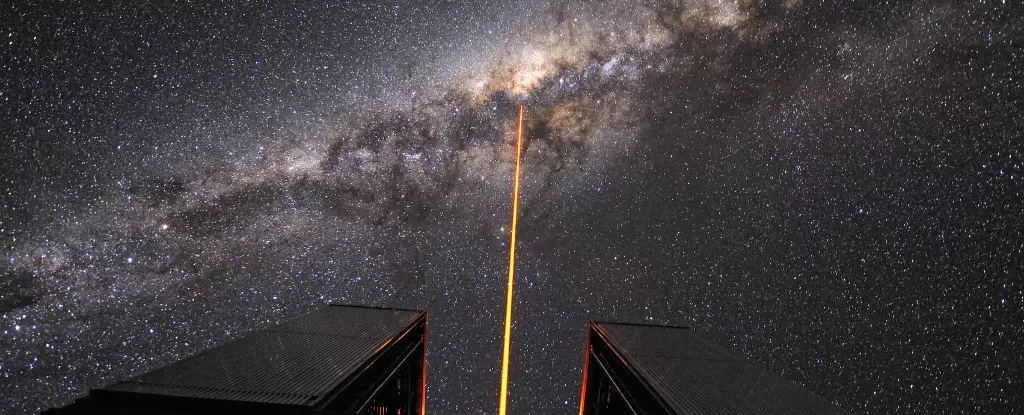The Milky Way is an intricate cosmic structure, yet at its core lies a celestial enigma: Sagittarius A*, a supermassive black hole that resides approximately 27,000 light years from Earth. Its immense gravitational pull and peculiar characteristics have long captivated astronomers and astrophysicists alike. Recently, a remarkable discovery by a team of astronomers led by Florian Peißker from the University of Cologne has unveiled a binary star system in close proximity to this mysterious entity. This revelation not only highlights the complexities associated with black holes but also sheds light on longstanding astronomical puzzles regarding star velocities and their evolutionary paths.
In the vast expanse of our galaxy, stars do not exist solely in isolation; many are part of binary or multiple star systems. A binary star system comprises two stars in a mutual gravitational dance, orbiting around a common center of mass. In contrast, our Sun exists as a solitary star, a fact that renders it significantly less vulnerable to catastrophic gravitational disruptions that could arise from a neighboring star intruding upon our solar neighborhood.
Statistically, it is established that approximately two-thirds of stars in the Milky Way are single, while the remainder exists in binary pairings. Such binaries are essential to astronomers because they provide insightful data on stellar masses through their orbital movements. By observing the behaviors of these binary stars, scientists can decipher their mass, velocity, and age — information that is often elusive for solitary stars.
The recent discovery of a binary system orbiting Sagittarius A* poses exciting implications for our understanding of stellar dynamics and the nature of black holes themselves. This finding adds yet another layer to the already complex issues surrounding the Milky Way’s core.
Detecting a binary star system in the vicinity of a supermassive black hole is not an easy task; it is fraught with technical challenges. The distance involved, coupled with the cosmic noise of the surrounding environment, makes direct observation nearly impossible. Instead, the research team employed sophisticated technology available at the European Southern Observatory’s Very Large Telescope to analyze starlight. Utilizing the Doppler effect — the observable shift in light frequency due to motion — the astronomers assessed the characteristic wobbles in the light emitted by the stars, confirming their companion status through intricate orbital motion.
Furthermore, the analysis provided astronomers with a captivating insight into the age of the binary system, revealing that the stars originated approximately 2.7 million years ago. This discovery suggests that these stars likely navigated into the black hole’s environment without being formed in that tumultuous vicinity, indicating a longer lifespan than previously anticipated within such a gravitational predator’s reach.
The gravitational interactions between celestial bodies can create a precarious balance, akin to our own Earth and its Moon orbiting the Sun. This gravitational dance is complex, characterized by multi-body interactions that can lead to potentially unstable systems. The recent scientific narrative likens this arrangement to a cosmic version of the well-regarded book and series “The Three Body Problem,” illustrating the complex interplay of diverse gravitational forces.
The findings surrounding hypervelocity stars — stars that traverse our galaxy at incredible speeds exceeding 1,000 kilometers per second — also build on this narrative. Traditionally, most stars exist in more stable, circular orbits with mean velocities of about 200 kilometers per second. The existence of hypervelocity stars introduces questions regarding their origins, with leading theories suggesting they were once part of binary systems that veered too close to Sagittarius A*. Ultimately, this gravitational interplay could eject one star whilst propelling another outward at extraordinary velocities.
The discovery of a binary star system around Sagittarius A* enriches our understanding of hypervelocity stars and supports existing theories about their formation. These findings represent a critical piece of the puzzle, linking the behavior of nearby stars to the mysterious dynamics of black holes. With this connection fortified, astronomers are better positioned to explore the complexities of our galaxy and the forces that govern it, providing fresh avenues for research into gravitational effects in such turbulent regions.
The journey of discovery concerning Sagittarius A* and its binary companions is a powerful reminder of the complexities of our universe. As technology continues to advance, allowing for deeper inquiries into the workings of celestial bodies, we can expect this dialogue to deepen, paving the way for greater comprehension of enduring astronomical mysteries. The cosmos is indeed a grand stage, and as new stars are born and others are ejected, the dance of celestial mechanics continues, inviting us to uncover its secrets.

